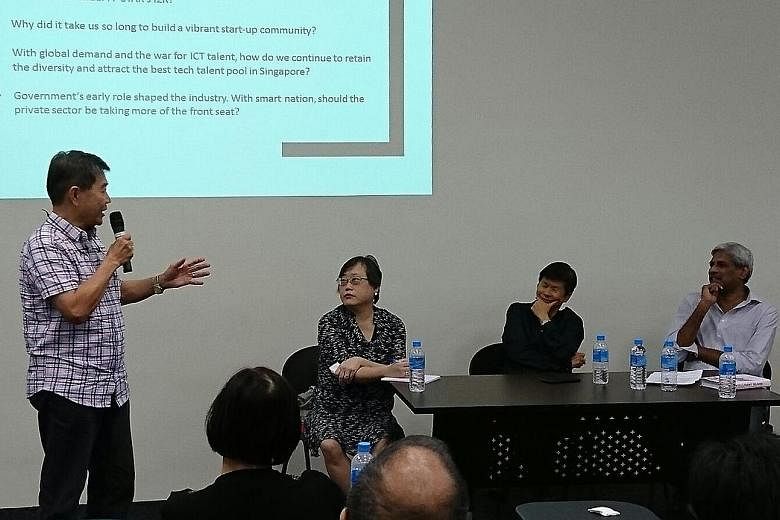Singaporean information technology (IT) pioneer Tan See Peng remembers well the days when the earliest IBM computer in Singapore, a mainframe as big as a bedroom, cost $3 million and ran at a speed of 60kbps. "Can you imagine, it was not even 1GB (in memory), which the phone in your pocket has today."
Mr Tan, 88, spoke to 90 readers at The Big Read Meet last Wednesday and added that he was "Member No. 010" of the Singapore Computer Society when it was set up in 1967. Like him, the society is still going strong. It turns 50 this year.
The Meet is the popular monthly non-fiction book club which The Straits Times runs with the National Library Board, and which this writer moderates.
He reflected on Singapore's experience with computerisation because the Meet was hosting Grace Chng and P. Ramakrishna, two pioneers of the infocommunications industry here. They are also the curators and co-authors of the book Intelligent Island, which captures the many little-known backstories of how the nation went from having only 850 IT professionals in 1980 to being one of the few countries with an artificial intelligence system by the late 1990s.
Chng is The Straits Times' former technology correspondent, while her old friend Ramakrishna retired in 2015 as director of industry development at the then Infocomm Development Authority of Singapore. He is now deputy chief executive of IT consultancy CIO Academy Asia.
In the question-and-answer session, Ramakrishna said it is ironic that there is now a buzz here about going cashless, following Prime Minister Lee Hsien Loong's musings about it at the National Day Rally on Aug 20.
Noting that Singapore had introduced cashless options such as Nets, CashCard and EZ-Link cards starting in the 1980s, he said "something fell through the cracks" after that, resulting in such payment options not being integrated into a single, seamless system.
"Maybe the Government should have been a super-regulator in this instance," he mused.
On Mr Lee's observation that cashless payments are big in China, Chng said that came about after China's online value-added services behemoth Tencent enabled its customers to give their friends and family members hongbao through its online channels.
If just 1 per cent of China's 1.38 billion population went cashless, Chng added, that would already be a massive market.
Singapore, however, did not have such a critical mass, noted William "Bill" Liu, 69, a co-author of Intelligent Island and another industry veteran.
Liu, who is now chairman and managing partner of private venture catalyst Stream Global, had tried to set up a cashless payment system for transactions other than transport fares when he was president of Green Dot Capital here.
"The first thing merchants ask is: Is it free?" he recalled, adding that for most of them, the cost of installing cashless payment terminals alone was prohibitive.
"Say a terminal costs $1,200. If you need 10,000 terminals, that is already $12 million," he pointed out. "So unless you have very deep pockets, most merchants would not be willing to spend that sort of money."
Other readers agreed, noting that merchants were often fixated on "cost recovery" instead of business opportunities.
Ramakrishna added: "The whole country has to agree on a standard for such payments. You need someone to say, 'Just do it'."
Liu later added that the need for a cashless payment system might be less pronounced in Singapore because first, the banks are very efficient in clearing cheques - within two days, compared with weeks in some countries - and second, there are automated teller machines everywhere, unlike in China.
Readers had many suggestions for the book's second edition.
Among them was retiree I.P. Wang, 73, also an industry pioneer, who asked: "In this book, you covered the Indian chiefs. What about the Indians?"
Ramakrishna said that, in the past, the Government's efforts to attract multinational corporations (MNCs) to invest in Singapore had resulted in home-grown IT talents and small and medium-sized enterprises here being "IT coolies", that is, existing mainly to "serve" MNCs.
The snag, he added, was that Singapore's IT talents could not own the technologies they had developed, giving everything over to MNCs, thus crippling their chances to "conquer the world" on their own steam.
Happily, he added, there is now a "strong effort" to commercialise IT breakthroughs from universities and research-and-development institutions here, such as the Agency for Science, Technology and Research (A*Star).
Meet regular Penny Chan, 56, a senior manager at a support centre for diabetics, asked whether Singapore's millennials have what it takes to propel the IT journey on.
Chng said: "I think they have the hunger. If you've got all the lowhanging fruit, what are left are the higher-hanging ones, so you've got to climb higher - and the jungle is very competitive."


